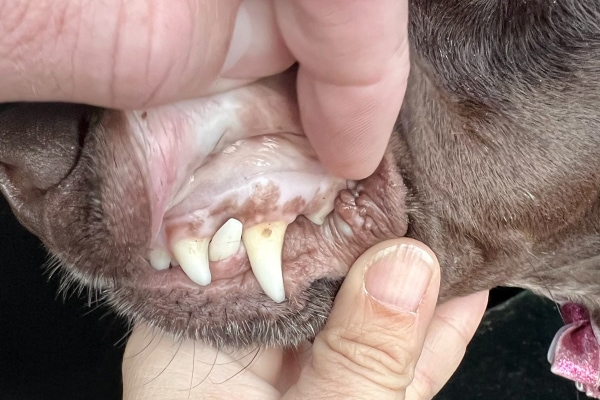White Gums in Dogs: Causes, Symptoms, and When to Seek Veterinary Care
Gum color is an important indicator of a dog’s overall health. Normally, a dog’s gums should be a healthy shade of pink, but sometimes they may appear white, which can be a cause for concern. In this article, we will explore the causes and symptoms of white gums in dogs and discuss when it is necessary to seek veterinary care.
Table of Contents
Toggle1. Introduction
Dogs rely on their gums to provide oxygen and nutrients to their bodies. The gums should have a healthy pink color, which indicates proper blood circulation. When the gums appear white, it suggests that something is amiss. White gums in dogs can be a sign of an underlying health issue that requires attention.
2. Understanding Gum Color in Dogs
Before we delve into the causes and symptoms of white gums in dogs, it’s essential to understand the range of gum colors that can be considered normal. While pink is the most common and healthy gum color, variations like pale pink, salmon pink, or pigmented gums can also fall within the normal range. The key is to be familiar with your dog’s baseline gum color, as any significant deviation can indicate a problem.
3. Normal Gum Color in Dogs
As mentioned earlier, the normal gum color in dogs is typically a healthy shade of pink. When you press on the gums, they should momentarily turn white but quickly return to their normal pink color within two seconds. This capillary refill time is an important indicator of blood circulation and hydration status in dogs.
4. White Gums in Dogs: Causes and Symptoms
White gums in dogs can be caused by various underlying conditions. Here are some common causes and their associated symptoms:
4.1. Anemia
Anemia, which is characterized by a decrease in red blood cells or hemoglobin, can lead to white gums in dogs. Other symptoms of anemia may include weakness, fatigue, pale mucous membranes, and loss of appetite.
4.2. Shock
When a dog experiences shock, inadequate blood flow can cause the gums to turn white. Shock can be a result of severe injury, blood loss, heart failure, or a severe allergic reaction. Alongside white gums, symptoms of shock may include rapid breathing, weak pulse, and lethargy.
4.3. Hypothermia
In cold environments or due to certain medical conditions, dogs can develop hypothermia. One of the symptoms of hypothermia is pale or white gums. Other signs include shivering, lethargy, and a drop in body temperature.
4.4. Blood Clotting Disorders
Certain blood clotting disorders, such as hemophilia or von Willebrand disease, can cause white gums in dogs. These disorders affect the dog’s ability to clot blood properly, leading to excessive bleeding and pale gums.
4.5. Gastrointestinal Issues
Gastrointestinal problems like gastric dilatation-volvulus (GDV), commonly known as bloat, can cause white gums in dogs. Bloat is a life-threatening condition where the stomach twists, leading to gas buildup and reduced blood flow. Other symptoms may include restlessness, bloated abdomen, and unproductive retching.
4.6. Toxicity
Certain toxins, such as rat poison or some household chemicals, can cause white gums in dogs. Alongside pale gums, symptoms of toxicity may include vomiting, diarrhea, tremors, seizures, or difficulty breathing.
5. When to Seek Veterinary Care
If you notice that your dog has white gums, it’s crucial to assess the situation and determine whether immediate veterinary care is necessary. Here are some guidelines to follow:
5.1. Monitoring Gum Color
Regularly check your dog’s gums for any changes in color. If the gums stay white or become paler over time, it is a cause for concern. Monitor their overall behavior and look for additional symptoms that may accompany the change in gum color.
5.2. Assessing Other Symptoms
Pay attention to other symptoms that your dog may be exhibiting. These can include weakness, lethargy, loss of appetite, difficulty breathing, or any abnormal behavior. The presence of these symptoms, alongside white gums, may indicate a serious underlying issue.
5.3. Seeking Immediate Care
In certain situations, immediate veterinary care is necessary. If your dog’s gums are white, and they are experiencing severe symptoms such as collapse, difficulty breathing, unresponsiveness, or profuse bleeding, it is crucial to seek emergency veterinary care without delay.
6. Diagnosis and Treatment
When you visit the veterinarian, they will perform a thorough examination to identify the underlying cause of the white gums. This may involve the following steps:
6.1. Veterinary Examination
The veterinarian will assess your dog’s overall health and check for any obvious signs of illness or injury. They will examine the gums, heart rate, breathing, and other vital signs to gain insights into the dog’s condition.
6.2. Blood Tests
Blood tests may be conducted to evaluate the dog’s red blood cell count, hemoglobin levels, and overall blood chemistry. These tests can help identify anemia, blood clotting disorders, or other systemic issues.
6.3. X-rays and Imaging
In some cases, X-rays or other imaging techniques may be required to examine the internal organs or identify any abnormalities. This can be helpful in diagnosing conditions like bloat or tumors.
6.4. Treatment Options
The treatment for white gums in dogs will depend on the underlying cause. It may include interventions such as blood transfusions, medications, surgery, or supportive care. The veterinarian will develop a treatment plan tailored to your dog’s specific needs.
7. Prevention and Home Care
While not all causes of white gums can be prevented, there are measures you can take to promote your dog’s overall health and well-being. Here are some preventive steps and home care tips:
7.1. Regular Veterinary Check-ups
Schedule regular check-ups with your veterinarian to monitor your dog’s health and catch any potential issues early. Routine examinations can help detect underlying conditions before they manifest as white gums or other symptoms.
7.2. Dental Health
Maintaining good dental hygiene is important for your dog’s overall health. Regular brushing, dental cleanings, and providing appropriate dental chews or toys can help prevent dental disease that could contribute to gum issues.
7.3. Proper Nutrition
Feed your dog a balanced and nutritious diet. Ensure they receive all the necessary vitamins, minerals, and nutrients to support their overall health. Consult your veterinarian for guidance on the best diet for your dog’s specific needs.
7.4. Monitoring Toxins
Be vigilant about keeping toxic substances out of your dog’s reach. This includes household chemicals, medications, certain plants, and food items that can be harmful to dogs. Awareness and prevention can help avoid potential toxicity-related white gums.
8. Conclusion
White gums in dogs are not to be ignored, as they can indicate underlying health issues that require attention. Monitoring your dog’s gum color and recognizing other associated symptoms is crucial in determining when to seek veterinary care. Early intervention and proper diagnosis can lead to effective treatment and a better prognosis for your furry companion.
9. FAQs
9.1. Can dental issues cause white gums in dogs?
Yes, dental problems such as gum disease or infection can contribute to gum discoloration, including white gums.
9.2. Are all cases of white gums in dogs serious?
While white gums can be an indicator of a serious underlying issue, not all cases are life-threatening. However, it is important to have your dog evaluated by a veterinarian to determine the cause.
9.3. Can dehydration lead to white gums in dogs?
Yes, severe dehydration can lead to pale or white gums in dogs. Adequate hydration is important for maintaining healthy gum color.
9.4. How long does it take for gum color to return to normal?
The time it takes for gum color to return to normal depends on the underlying cause. Once the underlying issue is addressed, gum color typically improves within a few hours to a few days.
9.5. Can stress cause white gums in dogs?
While stress alone may not cause white gums, it can contribute to changes in gum color. Stress can affect blood circulation and overall health, potentially leading to pale or white gums in dogs.
Read More:Healthy Dog Teeth – Tips for Keeping Your Dog’s Teeth Clean
White Gums in Dogs: Causes, Symptoms, and When to Seek Veterinary Care













